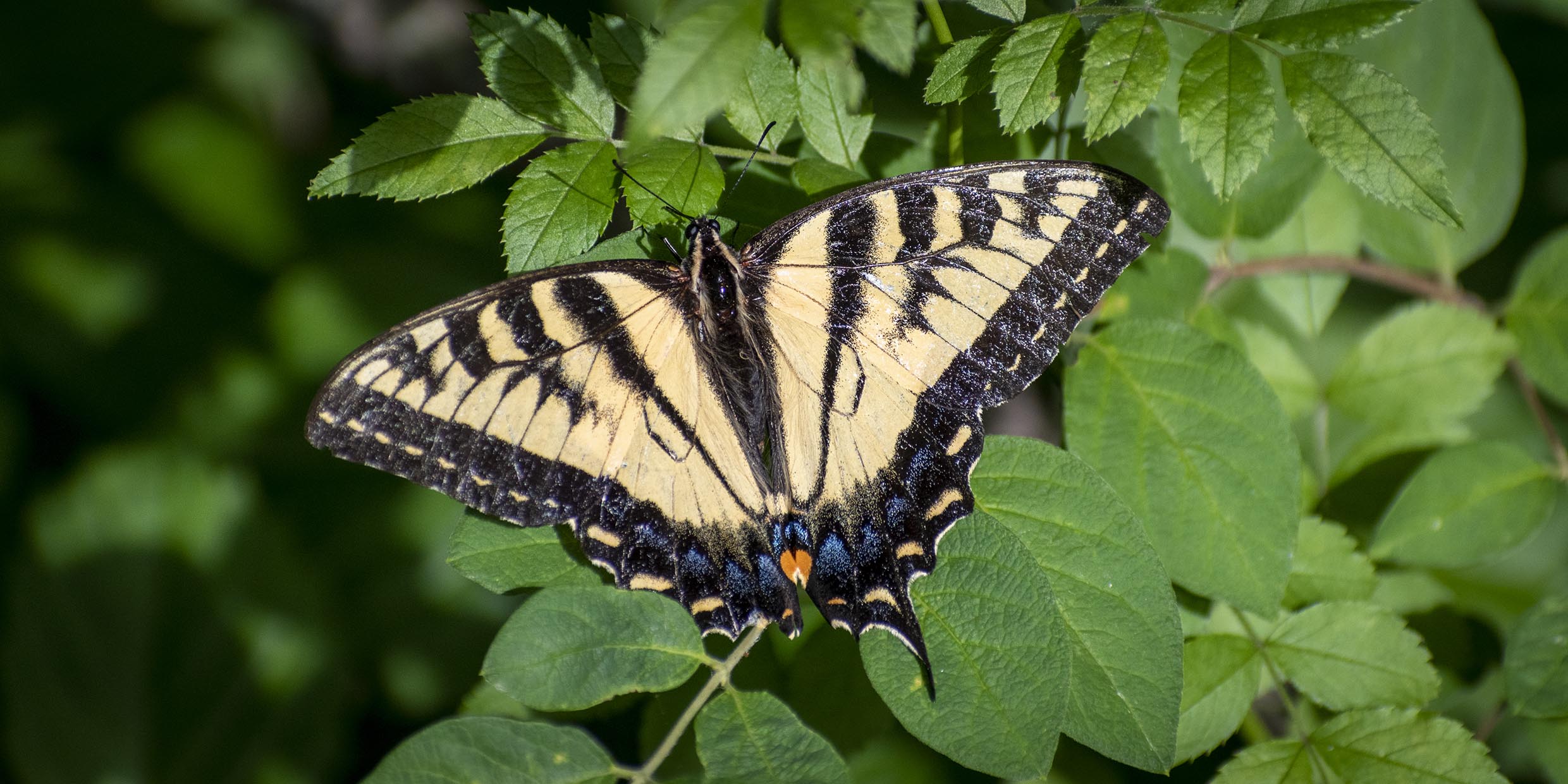Originally published 1 June 1998
It was one of those blessed days.
In the morning I saw a tiger swallowtail butterfly. It was cold, or exhausted. I touched it.
Later in the morning I watched a cowbird chick hatch in a nest with four white phoebe eggs — a trickster parasite, laid by the cowbird mother, to be raised by the unsuspecting phoebe parents.
Then, in the afternoon, a second tiger swallowtail, this one in fine fettle, flitting in the meadow.
And what a butterfly!
A wingspan as big as my palm. Vivid yellow with black tiger stripes. Patches of iridescent orange and blue along the margin of the hind wing. The characteristic swallow tails trailing behind.
Someone said to me recently that the greatest prayer is “Wow!” I watched that tiger swallowtail flit. I followed it with my binoculars. I prayed: “Wow! Wow! Wow!” A symphony of color and motion. More beauty than would seem to be necessary for the mere business of flitting, mating, laying eggs.
But, of course, nothing in nature is “mere.”
Which raises the very “un-mere” question: Why is the butterfly beautiful? Or alternately, why do we think the butterfly is beautiful?
The 19th-century naturalist Alfred Russel Wallace, co-originator with Darwin of the theory of evolution by natural selection, encountered a birdwing butterfly on an island in the Malay archipelago. His description is worth quoting at length:
“The beauty and brilliancy of the insect are indescribable, and none but a naturalist can understand the intense excitement I experienced when I at length captured it. On taking it out of my net and opening the glorious wings, my heart began to beat violently, the blood rushed to my head, and I felt much more like fainting than I have done when in appreciation of immediate death. I had a headache the rest of the day, so great was the excitement produced by what will appear to most people a very inadequate cause.”
I suspect that most people encountering a birdwing butterfly in the forest for the first time would have a similar response. There is something universal about our perception of beauty, something that seems to be a part of human nature.
Philosophers and poets since Plato — or before — have debated the origin of our aesthetic sense.
“Beauty is Truth, Truth Beauty,” says Keats (or more accurately, says Keats’s Grecian urn). The poet W. H. Auden disagrees: Truth and beauty are not identical, he says. Beauty is that “which gives us delight precisely because of its contrast to our historical existence with all its insoluble problems and inescapable suffering.” In other words, beauty is that which distracts us from truth.
The critic John Ruskin, in Modern Painters, describes a time when he gazed in wonder upon a storm in the Alps — thunder and lightning crashing among towering spires of rock, valley, river, forest. He writes: “And then I learned — what till then I had not known — the real meaning of the word Beautiful.” Beauty, he tells us, is that which turns the human soul from gazing upon itself.
All of which sounds terribly profound, but none of which tells us very much about the source of the exclamatory “Wow!.”
We do know something about the origin of the tiger swallowtail’s finery. The beautiful colors are produced by a combination of chemical pigments and refraction of light by thin translucent layers in the scales of the wings. Chemistry and physics; it’s all chemistry and physics.
But why the gaudy pigments, why the iridescent scales? That can be a matter of sexual selection, say the evolutionary biologists. Gaudier and “flittier” insects manage to attract mates and successfully propagate their genes. Broad, bright wings may indicate physical fitness in a potential mate.
Other forms of coloration provide camouflage, mimicry of poisonous or distasteful species, distraction from vital parts of the insect’s anatomy, or the ability to startle predators — all of which confer an advantage in the struggle for life.
Our own ability to recognize and respond to beauty almost certainly has a similar origin. Our brains were shaped by interaction with a world that contains a neatly balanced mix of order and chaos.
Negotiating our way successfully through such a world undoubtedly placed selective value on certain kinds of perceptual responses. Our aesthetic sense may be subtly adaptive, or perhaps a by-product of some useful adaptation.
We don’t know much about this yet, but new three-dimensional scanning technologies are making it possible to watch the living brain in action. We need to observe brains as experimental subjects respond to beautiful and ugly stimuli, and then try to coordinate these responses with other sorts of mental activity or responses to stimuli, looking for likely adaptive connections.
We might even be able to track down beauty genes.
Much work remains to be done, but it can hardly be doubted that some part of our response to the tiger swallowtail’s beauty is hardwired into our brains by millennia of evolution, and that our standards of beauty are somehow related to patterns of order and chaos in those natural environments that were our species’s nursery.
Beauty may be in the eye of the beholder, but only because our brains are adapted to a beautiful world. “Beauty is nature’s fact,” wrote Emily Dickinson, and she may be the poet who got it best of all.



